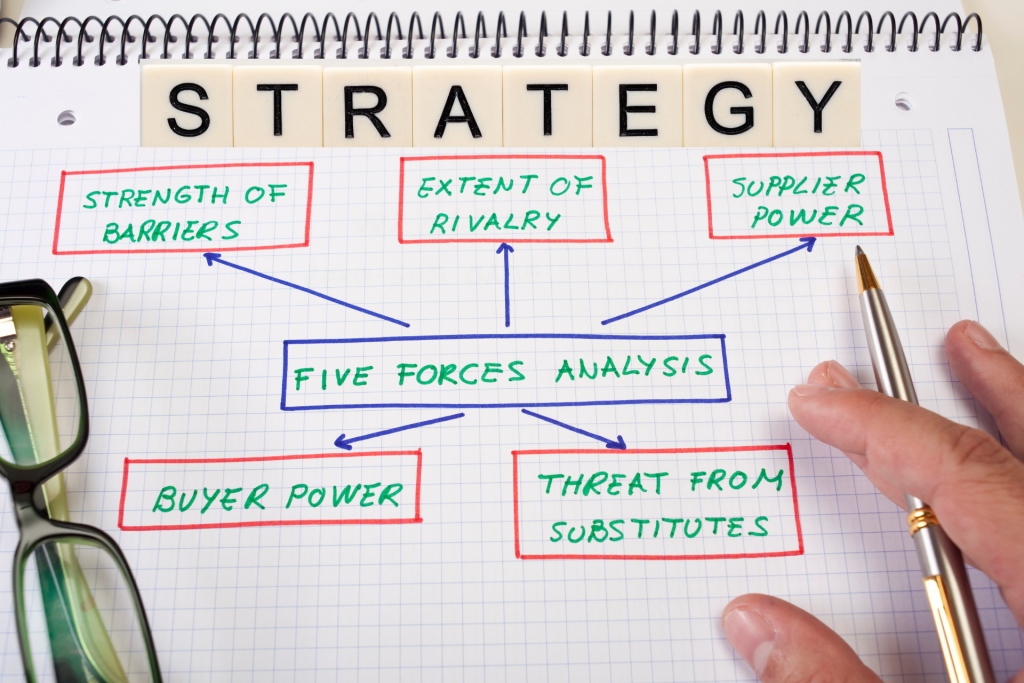What is Strategy?
Strategy is a comprehensive plan that outlines how an organisation will achieve its goals and objectives. It involves making decisions on resource allocation, setting priorities, and taking actions to ensure long-term success.
Bite Size ‘Simple Steps’ (TLDR) – 4 Steps to Implement Strategy Development in a Yoga Studio Business
1. Assess the Competitive Environment
- Action: Use Porter’s Five Forces model to analyze the competitive dynamics of the yoga studio market. Identify key factors such as the threat of new entrants, bargaining power of suppliers and customers, substitutes, and the level of competitive rivalry.
- Example: Identify the number of yoga studios in your area, assess the popularity of alternative fitness options like Pilates or online yoga, and evaluate the power of your suppliers (e.g., yoga mat suppliers) and customers (e.g., pricing sensitivity).
2. Identify Strategic Opportunities and Threats
- Action: Based on the Five Forces analysis, pinpoint potential opportunities to leverage and threats to mitigate. Consider areas where your studio can differentiate itself or improve its offerings.
- Example: If there is a growing trend of wellness retreats, consider offering weekend yoga retreats. If online classes are a threat, enhance your in-studio experience to provide added value.
3. Develop a Comprehensive Strategy
- Action: Formulate a strategy that outlines how your yoga studio will achieve its goals by capitalizing on opportunities and addressing threats. This strategy should include resource allocation, marketing tactics, and service offerings.
- Example: Decide to allocate resources towards creating a unique brand experience by offering specialized classes, hiring highly qualified instructors, and investing in a community-focused marketing campaign.
4. Implement and Monitor the Strategy
- Action: Execute the strategy and regularly monitor its effectiveness. Be prepared to adapt your approach based on market feedback and changes in the competitive environment.
- Example: Launch the new specialized classes and community events. Monitor class attendance, customer feedback, and competitor activities to adjust your strategy as needed, ensuring continued relevance and success.
The Importance of Strategy Development
Effective strategy development enables organisations to:
- Identify and leverage opportunities
- Mitigate risks and threats
- Optimise resource utilisation
- Gain a competitive advantage
- Ensure long-term sustainability
Porter’s Five Forces Model
One of the most influential tools for analysing an organisation’s competitive environment is Porter’s Five Forces model. Developed by Michael Porter in 1979, this model helps organisations understand the dynamics of their industry and shape their strategies accordingly.

The Five Forces
1. Threat of New Entrants
The likelihood of new competitors entering the industry can impact an organisation’s market position. High barriers to entry, such as economies of scale, brand loyalty, and regulatory requirements, can deter new entrants and protect existing players.
2. Bargaining Power of Suppliers
Suppliers can influence an organisation’s costs and quality of inputs. When there are few suppliers or unique resources, their bargaining power increases, potentially leading to higher costs and reduced margins for the organisation.
3. Bargaining Power of Buyers
Buyers can exert pressure on organisations by demanding lower prices, higher quality, or additional services. The bargaining power of buyers is higher when they are concentrated, purchase in large volumes, or have alternative sources of supply.
4. Threat of Substitute Products or Services
The presence of alternative products or services can limit an organisation’s pricing power and market share. Organisations need to monitor substitute products and innovate continuously to stay competitive.
5. Intensity of Competitive Rivalry
The level of competition within an industry affects profitability and market share. High competitive rivalry, characterised by numerous players, slow industry growth, and low differentiation, can erode an organisation’s market position.
Applying Porter’s Five Forces in the Public Sector
While Porter’s Five Forces is primarily used in the private sector, it can also be applied to the public sector to analyse competitiveness and market attractiveness for government intervention.
Adapting the Model
- Threat of New Entrants: Regulatory barriers and government policies can influence the entry of new players in the public sector.
- Bargaining Power of Suppliers: Government agencies often have significant leverage over suppliers due to large-scale procurement and budgetary constraints.
- Bargaining Power of Buyers: Citizens and taxpayers act as buyers, influencing public services’ quality and delivery.
- Threat of Substitutes: Alternative public services, non-profits, and private entities can serve as substitutes, impacting public sector organisations.
- Competitive Rivalry: Public sector organisations may face competition from other governmental bodies, private firms, or non-profits, affecting their effectiveness and efficiency.
Conclusion
Developing an effective strategy within organisations requires a thorough understanding of both internal and external environments. Porter’s Five Forces model offers valuable insights into the competitive landscape, enabling organisations to make informed strategic decisions. By adapting and applying this model, both private and public sector organisations can enhance their competitiveness and achieve their long-term objectives.
FAQ
What is the primary purpose of strategy development in organisations?
The primary purpose of strategy development is to create a comprehensive plan that helps an organisation achieve its long-term goals and objectives, optimise resource utilisation, and gain a competitive advantage.
How does Porter’s Five Forces model help in strategy development?
Porter’s Five Forces model helps organisations understand the competitive dynamics of their industry, identify opportunities and threats, and make informed strategic decisions to improve their market position.
Can Porter’s Five Forces be applied to the public sector?
Yes, Porter’s Five Forces can be adapted and applied to the public sector to analyse competitiveness, regulatory barriers, supplier and buyer influence, substitutes, and competitive rivalry.





